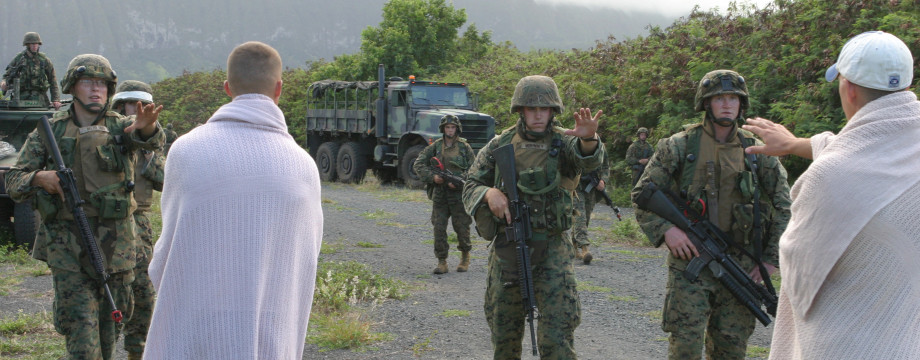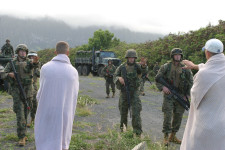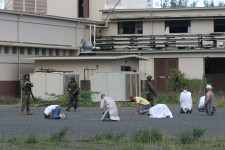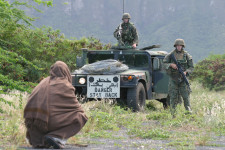
India Company, Marine Corps Training Area Bellows. October 2005.
“Battalion conducted Platoon Evaluations.” — Source: 3/3 Command Chronology for the Period 01 July to 31 December 2005
Contents
3/3 Command Chronology
Battalion conducted Platoon Evaluations.
News
Marines from Lima, Kilo and India companies of 3/3 train in desert atmosphere
By Cpl. Megan L. Stiner | October 12, 2005
MARINE CORPS TRAINING AREA BELLOWS, Hawaii — Marines with 3rd Battalion, 3rd Marine Regiment, participated in pre-deployment training in order to familiarize themselves with situations and scenarios they will more than likely experience in theater.
When Marines go to the field to train, they are usually performing a mission with one main focus, such as convoy operations, assaults, patrols, or initial action drills. The Marines of 3/3 were challenged over a two-week period as each platoon from India, Kilo and Lima companies participated in a two-day exercise that encompassed all of this training at one time.
“Performing all the training over a two-day period allows the Marines to gain a more realistic experience,” said Capt. Andy D. Lynch, company commander, India Company, 3/3. “The pace of the operations mimics the environment that the Marines need to learn to operate in.”
The knowledge and experience the Marines gain through various field-training exercises will prepare them for the unit’s upcoming deployment to Iraq.
“We began at the individual Marine level and from there, we worked up through fire teams and squads. We are now at the platoon level,” said the Chicago native. “Going through all the different levels allows us to evaluate the Marines and see what we need to work on.”
For this training evolution, the Marines were given a half day to prepare — after receiving a warning order, which lets them know the basics of a situation so they can begin preparing a strategy. After they receive an operation order, they refine their technique and make any final adjustments to their plan of attack.
On the day of the mission, the Marines were extracted from Marine Corps Base Hawaii by Blackhawk helicopters and inserted into Marine Corps Training Area Bellows.
Once at Bellows, they began their movement and encountered different situations such as improvised explosive devices, while patrolling to a bunker. Once they reached the bunker, they performed a cordon and search inside where they met opposition from 12 Iraqi insurgent role players who were waiting inside.
“We served as a training tool,” said Cpl. Stuart A. Clark, gunner, Combined Anti-Armor Team Platoon, Weapons Company, 3/3. “We set up a realistic scenario and tried to play the part of insurgents as well as we could.”
The Marines then had to kill or capture the enemy combatants and check for any useful documents before leaving the bunker and beginning their next move.
Clark, a Cocoa, Fla. native, explained that the Marine role players would lazily sling their weapons around, not speak English, and wear Iraqi-looking attire for effect. They also had a couple role players who would surrender to give the Marines the opportunity to deal with that aspect of training.
After the assault on the bunker, they met up with Marines from CAAT and began preparations for the convoy operations segment of training. The convoy portion tested the Marines immediate-action drill skills when they came across an ambush. They were also responsible for setting up and securing a vehicle checkpoint.
“It’s a lot of movement and planning for one day of training,” said Lance Cpl. Ian L. Ladmirault, team leader, India Company, 3/3. “That is one of the reasons why it is good training, though.
“It benefits us to do combined training like this, because everything we are doing helps prepare us for what we could come in contact with in one day in Iraq.”
Once they had set up the checkpoint, they did a walking patrol through an Iraqi village where they had to make contact with the village elder and communicate their intentions in order to establish a good relationship with the villagers after which they could gain intelligence.
“We had role-playing experience from being in Afghanistan, going through cultural classes and learning customs and courtesies,” said Cpl. Christopher Kelbaugh, squad leader, 81 mm Mortar Platoon, Weapons Company, 3/3, who also played the role of the village elder. “Personally, I was responsible for talking to the Marines and bargaining with them.”
Kelbaugh, a West Minster, Md. native, explained that he and the role-players were not aggressive toward the Marines, so if the Marines agreed to help them, he would give them information regarding insurgents, weapons caches, and anything else they needed to know.
“We did things like wear garments like those you would see in Iraq, not speak any English, and stop to pray when the time came,” said the 20-year-old. “Our whole job was to be in character as much as possible to make it seem realistic, and I think we did that.”
“Overall, the Marines are looking pretty good,” said Lynch, 30. “Each platoon has its own strengths and weaknesses, and that is why we evaluate the training. We know what to work on, and now we can use that and move forward.”
The unit’s next big training exercise will take them to military operations in the urban terrain area aboard Schofield Barracks for tactical and technical procedures, in late October.
Source: Hawaii Marine
Photographs
- India Company, Marine Corps Training Area Bellows. October 2005.
- India Company, Marine Corps Training Area Bellows. October 2005.
- India Company, Marine Corps Training Area Bellows. October 2005.
Video
India-3 passing Kailua and Lanikai en route to Marine Corps Training Area Bellows



